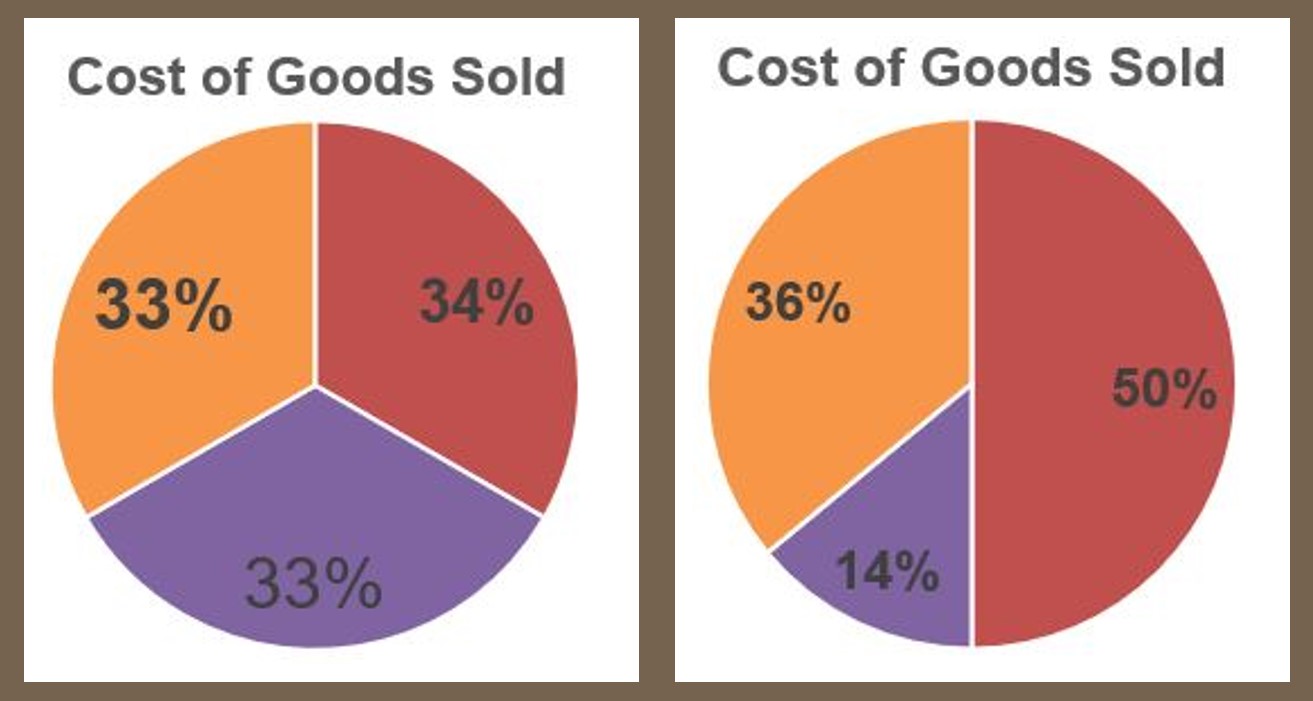These are unique times in the business world right now. Many middle-market and SME’s (small and medium-sized enterprises) will return to work and cash flow will be on everyone’s mind. I want to share a four-part series on how to increase cash flow in your manufacturing operations.
The default thought process might be to cut employees to conserve cash. But who will be left to build your product as demand comes back? I want to share other ways to increase cash flow in your business.
Let’s look at the typical Cost of Goods Sold (COGS) for a manufacturer. The three main COGS items are Labor, Overhead and Material.
How many of you believe that the three costs are equal like the pie chart on the left?
How many believe that the three costs more like the pie chart on the right?

For many companies that build a product, the COGS resemble the pie chart on the right. The material makes up about 50% of the COGS. A typical range is 35-50% of COGS. Overhead usually ranges between 25-36% of the COGS.
The smallest piece of the pie is labor. This can range between 14-20% of COGS. Think about the products you manufacture. How many labor hours go into building one of your units? One, two, five, ten?
If our goal is to free cash within manufacturing, let’s look at this another way. According to readyratios.com, the typical number of days of inventory for manufacturing is 76 days. This has changed little since 2013. Here is a screenshot and full report can be found here.

If we are a $25M company with a gross margin of 36% like in the example above, our COGS is $16M.
Keeping 76 days of inventory that means we have 3.3 inventory turns. 250 working days/76 days of inventory = 3.3 inventory turns. Since we have 3.3 inventory turns that means we carry about $16M/3.3 turns = $4,840,000 in inventory.
If our direct labor cost is 14% of our COGS, our direct labor costs are $16M x .14 = $2,240,000.
Since we are trying to save cash, let’s look at the impact of reducing inventory or labor by 20%.
Inventory = $4,800,000 X .2= $960,000
Labor = $2,240,000 x .2 = $448,000
Our savings are greater if we can eliminate the inventory investment by 20%. After eliminating that inventory, we now have 4.1 inventory turns.
What would happen if we could get to 12 inventory turns? Our inventory investment would be $1.3M. Which is a savings of $3.5M over the original $4.8M inventory investment. For mid-market and SMB’s this is a realistic target.
How do you free up that cash without having continual shortages? One of the most effective ways is to implement pull systems in your business. Also called Kanban systems, these are fantastic for minimizing inventory investment and ensuring that you don’t run out of parts to keep your business running.
This blog is the first of a four-part series that will educate you on these powerful tools and how you can deploy them in your organization.
In the meantime, here is an article from the Cincinnati Post in 1998 talking about this technique. I deployed it within a family-owned crane manufacturer, and it helped them successfully weather the 911 crisis. Here is the link.
Next week, I will discuss how to get started using this powerful method!
As always, it is an honor to serve you and I hope that you and your company are getting better every day!
Follow me on Twitter@dailyleancoach
Join me on LinkedIn
Listen to the podcast here

